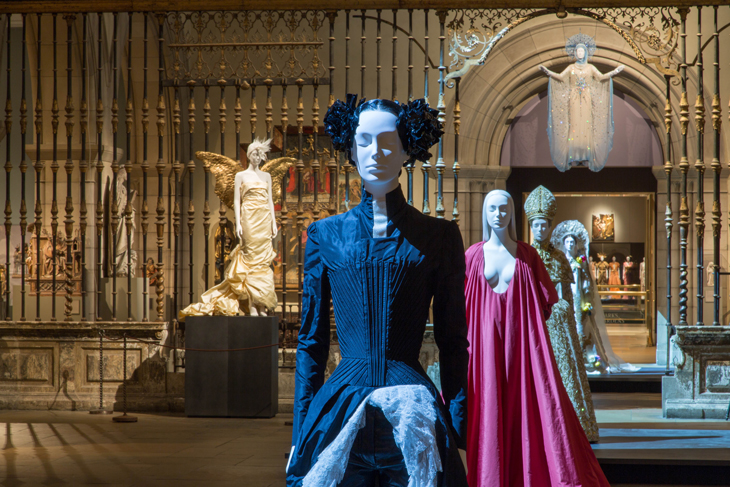If there is a clear divide between the sacred and the profane, you could be forgiven, wandering through the Met’s vast and variegated show ‘Heavenly Bodies: Fashion and the Catholic Imagination’, for losing track of it. In the medieval and Byzantine galleries and Lehman Wing of its Fifth Avenue location, and even in the more consistently conceived, austere section at the Cloisters uptown, there are reminders that what might seem a subversion of traditional Catholicism may instead be a smooth and logical extension of it. The haute couture touches of sadomasochistic eroticism or kitschy wit – a ‘penance’ dress complete with embroidered thorn stems and a black, rubber snake attached; a black gimp mask of thick-buckled belts, strands and rosaries; a silver crown of thorns by Alexander McQueen – seem very much in keeping with some of the religious iconography on display.
Meanwhile, those touchstones of maximal shock-and-awe excess of the 1980s and ’90s, such as Gianni Versace’s metallic-mesh sheaths, Thierry Mugler’s gold lamé dress with the shoulder wings spiking up past ear-level, or Christian Lacroix’s ‘Gold-Gotha’ jacket studded with gems, seem to lose their parodic edge in the face of the lavish collection of papal jewellery and vestments to be found downstairs at the Costume Institute, on rare loan from the Vatican.

Installation view of ‘Heavenly Bodies: Fashion and the Catholic Imagination’ at the Metropolitan Museum of Art, New York. Photo: © The Metropolitan Museum of Art, New York
There, alongside John Paul II’s blood-red shoes and gilded gifts from the likes of Benito Mussolini, you’ll find a cope laden with gold and a tiara dripping with diamonds and other stones, some 19,000 in all. Pius VI got to contemplate his own profile on his ring, rendered entirely in diamonds; Leo XIII had to make do with his name in sapphires, but the rest of his clasp, with its design featuring a crown and keys to the pearly gates, offers about 700 diamonds to compensate. The only place where a hint of simpler or more otherworldly spirituality seems to enter is in a chasuble designed in around 1950 by Matisse, in which green cacti complement crucifixes.
The overall tone of the exhibition, in which the sensual tends to overwhelm any analysis or context, is tricky to read. While some of the influences – a Lanvin gown based on a painting by Fra Angelico, for example – are easily traced, other links, whether conceptual or only at the level of line or texture, are less fully revealed. The curator, Andrew Bolton, apparently keen to avoid anything that might smack of blasphemy, errs on the side of an exaggerated reverence. The show emphasises the elements of mystery and storytelling that connect the modern designs with their inspiration while rather undercutting their daring. Holy music wafts around the frantically instagramming crowds. The enthusiastic embrace of smoke and mirrors can make it harder to appreciate the true, earthly magic of what’s on display here – how the clothes are constructed – and it adds a perhaps-not-quite-intentional sheen of irony to the transcendent bling from the Vatican, among the most jubilant celebrations of institutional power and wealth in existence.

Installation view of ‘Heavenly Bodies: Fashion and the Catholic Imagination’ at the Metropolitan Museum of Art. Photo: © The Metropolitan Museum of Art, New York
Perhaps that’s why the Cloisters section of the show, which both heightens and elegantly resolves some of these tensions, is the most impressive and unsettling. The famous cloaklike Balenciaga wedding dress of 1967 in ivory silk and organza commands an entire room, its stitching (only three seams in the whole garment) hidden like the face of the imaginary wearer, who is protected by a headdress, the shape of which gently follows that of the gown itself. Many of the pieces are arranged outdoors in the Cloisters’ courtyards. The extravagantly long black Valentino cape, with its descending arches expanding in size towards the bottom hem, seems to refer both to its immediate surroundings and to the Colosseum in Rome, and captures the mood of the section as a whole; its lines, shadows and empty spaces evoke some of the negative capability required for actual religious faith far more deftly than any of the reckless ostentation seen elsewhere.
This is not to say that all the garments shown in the Cloisters are monastic and muted. Entire gardens of Eden creep into view as scenes from Hieronymus Bosch and Lucas Cranach the Elder and various stained-glass designs are screen-printed or embroidered on gowns and shoes. A bride envisioned by Thom Browne, swathed in mink, pearls and crystals, seems to step through a huge white cloud; Jean Paul Gaultier decorates the breast of his Virgin-blue bias-cut gown of 2007 with a glittering sacred heart stabbed by a metal dagger, bleeding silky red all the way down. Nonetheless, the atmosphere has shifted: gone are the gigantic wooden wings and endlessly repeated gold spikes and profusion of different-coloured gems. Here the eroticism of the spiritual is heightened by strict curatorial restraint.
The result is that whereas the insistently solemn displays at Fifth Avenue begin to pall and blur, the Cloisters section makes a far more compelling case for the show’s thesis about the influence of Catholic thought, ritual, and iconography on many of the great designers of the 20th century and beyond. Without sacrificing rebellious wit, many of these pieces suggest how the sacred may have structured the profane – visually and intellectually – in ways both subtle and flagrant.
‘Heavenly Bodies: Fashion and the Catholic Imagination’ is at the Metropolitan Museum of Art, New York, until 8 October.
From the September issue of Apollo. Preview and subscribe here.
Unlimited access from just $16 every 3 months
Subscribe to get unlimited and exclusive access to the top art stories, interviews and exhibition reviews.














![Masterpiece [Re]discovery 2022. Photo: Ben Fisher Photography, courtesy of Masterpiece London](http://www.apollo-magazine.com/wp-content/uploads/2022/07/MPL2022_4263.jpg)
Suzanne Treister’s tarot offers humanity a new toolbox